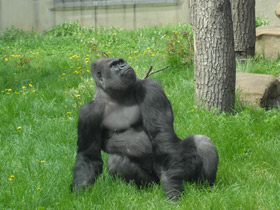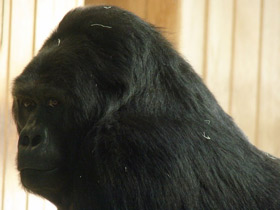The genus Gorilla>
Gorillas are herbivorous, predominantly ground-dwelling great apes that inhabit the tropical forests of equatorial Africa. The genus Gorilla is divided into two species: the eastern gorilla and the western gorilla, and either four or five subspecies. The DNA of gorillas is highly similar to that of humans, from 95 to 99% depending on what is included, and they are the next closest living relatives to humans after chimpanzees and bonobos.
Appearance and nutrition
The genus Gorilla is the largest primate species. These apes have a fearsome appearance: males reach a weight of 250 kg and a height of about 2 m (females, however, are half as small). However, all researchers who observe gorillas in the wild point out that they have a rather peaceful temperament. Gorillas are found in the dense, humid tropical forests and mountainous areas of central Africa.
Because of their size, they live and feed mainly on the ground. Ironically, these giants are true vegetarians. Their huge jaws and powerful chewing muscles allow them to manipulate almost any type of plant food: bark, wood, stems, roots and leaves. Succulent fruits make up only 2% of their diet, and gorillas also eat insect larvae and snails in small quantities. They are active during daylight hours and as dusk approaches they begin to build nests in trees or on the ground at night. The young usually spend the night in their mother's nest.
Lifestyle
Gorillas are primarily terrestrial and quadrupedal animals - they walk on the soles of their hind limbs and on the toes of their forelimbs. However, in West Africa, where there are many more fruit trees than in East Africa, adults - including the huge males - spend considerable time high up in the trees, feeding on fruit. Lighter individuals even jump from tree to tree on their hands, while the younger ones play in the treetops. Although gorillas prefer fruit, including figs, they will again opt for foliage, shoots and stems in those areas and at times when fruit is scarce. The species of sedges, grasses, shrubs and vines that make up the gorillas' substitute diet grow in swampy, hilly areas or in forest plantations, where an open forest canopy allows sunlight to reach the ground.
The enormous size of gorillas and the fact that they are vegetarians forces these primates to spend many hours foraging for food. This prevents them from regularly migrating long distances, and although their range can vary from 5 to 30 square kilometres, the daily route of a typical group is only 0.5 to 2 kilometres. Unsurprisingly, gorillas cannot be territorial, as they are physically incapable of defending the boundaries of their territory. The territories of neighbouring gorilla family groups overlap to a large extent, and even the most actively used central parts of these territories may overlap.
Social behaviour and reproduction
Gorillas live in relatively stable groups of 5 to 30 animals. Such a group may contain one adult male sylverback - the leader, 1-2 immature males, 3-6 adult females over 8 years old, intermixed with the leader, and 3-10 offspring of different ages. (Interestingly, recent studies have shown that about one-third of family groups include 2 adult males at a time). Adult females in a harem are not usually related by kinship and social bonds between them are very weak, so the family group is not held together by them, but by the bond of each female to a silverback male.
Females give birth approximately once every 6-8 years. The newborn weighs between 1.8 and 2 kg and is totally defenceless. It begins to crawl at 9 weeks of age and to walk at 30-40 weeks. It is exclusively breastfed for the first 8 months, but is sometimes fed by the mother until it is three years old. If a young female remains in her own group, her mother's support is important to her, even much later, when she has her own baby.
Females reach sexual maturity at 7-8 years and males at 10 years, but young gorillas begin breeding much later (males no earlier than 15-20 years). Three-quarters of young females and half of males leave the family group in which they were born. Females usually join the neighbouring feral group, but do not necessarily stay with it forever.
Young males that have left their group have to wander alone or with other males for a while, and sometimes it takes years before they manage to acquire females from other groups and create their own harem. If this finally happens, the male usually stays with her for the rest of his life. It must be said that their life is very turbulent, as strange males often try to take their females, and they have to defend them.
When two silverbeckers meet, they first try to scare each other by beating each other's chests, growling menacingly, tearing off thick branches and jumping sharply in different directions. Battles between group leaders and bachelors can be so violent as to cause serious injury or even death to the weaker male. Obviously, the large size is a great advantage.
Thus, competition between males is almost certainly the explanation for such pronounced sexual dimorphism in gorillas (males are almost twice as large as females, have more powerful jaws and huge fangs capable of inflicting serious wounds; they have a high bony ridge in the middle of the skull; and they even have a different colour than females).
Threat to existence
Gorillas are listed as Critically Endangered on the IUCN Red List. The main threats are deforestation and poaching.
Classification
Until recently, gorillas were considered a single species, with three subspecies: the western gorilla, the eastern gorilla and the mountain gorilla. The gorilla is now considered to be divided into two species, each divided into two subspecies. More recently, a third subspecies has been claimed to exist in one of these groups.
Scientists continue to study the relationships between the different forms of gorilla. They are listed below according to the classification with the greatest scientific consensus:
- Western gorilla (Gorilla gorilla gorilla);
- Western lowland gorilla (Gorilla gorilla gorilla gorilla gorilla);
- Cross River gorilla (Gorilla gorilla gorilla diehli);
- Eastern gorilla (Gorilla beringei);
- Mountain gorilla (Gorilla beringei beringei);
- Eastern lowland gorilla (Gorilla beringei graueri).
A third subspecies of eastern gorilla has been proposed, which has not received a full Latin name: it is the Bwindi mountain gorilla population; this form is sometimes called the "Bwindi gorilla".
Using the CoalHMM system, the aim is to analyse when the two gorilla species (western and eastern gorillas) diverged. To do this, the genomes of two individuals of the Gorilla gorilla species and one Gorilla beringei were analysed. According to the estimation (molecular clock), the gorilla populations separated 1.75 million years ago.
Subsequently, the homozygosity/heterozygosity ratio was analysed, showing that the ten times smaller population, Gorilla beringei, has a higher homozygosity/heterozygosity ratio; therefore, it is claimed that they have a lower genetic variability.
Among the differences between species, 1615 SNPs in 1326 genes were observed; seven of them with more than four amino acids involved, mainly affecting immune response proteins (EMR3) and olfactory genes.

















































